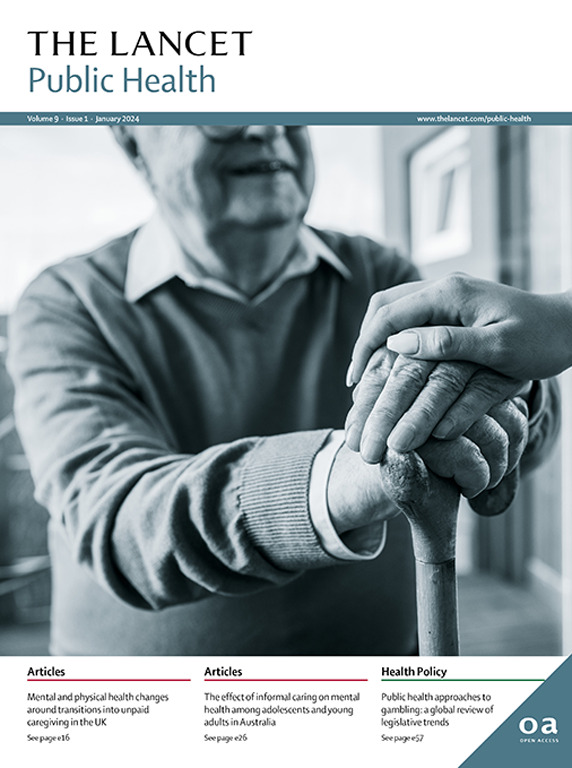中国儿童和青少年瘦弱和肥胖的趋势与不平等:1985 年至 2019 年期间七次全国学校调查的证据
IF 25.2
1区 医学
Q1 PUBLIC, ENVIRONMENTAL & OCCUPATIONAL HEALTH
引用次数: 0
摘要
背景在中国,有关当代儿童和青少年营养不平等的最新数据很少,尤其是与城乡居住地和地区社会经济地位(SES)有关的数据。我们的目的是评估中国儿童和青少年在瘦弱和肥胖方面的不平等现象。方法我们从七次中国全国学生体质与健康状况调查(1985、1995、2000、2005、2010、2014 和 2019 年)中获得了 1 677 261 名 7-18 岁儿童和青少年的体重和身高测量数据。采用性别特异性 BMI 年龄 Z 值来定义瘦弱(Z 值为 <-2SD)和肥胖(Z 值为 >+2SD)。城乡分类来自《统计城乡分区代码》,学校所在省份的人均国内生产总值(GDP)被用作社会经济地位的替代指标。T1 代表社会经济条件最差的省份,T3 代表社会经济条件最优越的省份。一般线性回归模型评估了患病率与人均国内生产总值之间的相关性,并通过最佳拟合模型得出了到2030年的预测值。研究结果肥胖症的平均患病率从1985年的0-10%(95% CI 0-09至0-11)上升到2019年的8-25%(8-13至8-37),而瘦弱症的患病率则从8-49%(8-41至8-58)下降到3-37%(3-29至3-45)。高社会经济地位省份的肥胖患病率从2014年(8-42%[8-19至8-65])大幅下降到2019年(7-73%[7-52至7-95])。从全国来看,从1985年到2019年,城市地区的男女肥胖患病率一直高于农村地区;然而,2019年,居住在T3地区的农村女孩的肥胖患病率高于城市女孩(城乡差距:-0-37% [-0-07 to -0-80])。除 1985 年和 1995 年外,在所有调查波次中,农村男孩的消瘦率均高于城市男孩。就女孩而言,在最近一次于 2019 年进行的调查中,没有观察到明显的城乡消瘦差距(-0-10% [-0-24 to 0-04])。从 1985 年到 2014 年,高社会经济地位地区的男孩和女孩与低社会经济地位地区的男孩和女孩相比,肥胖风险更高,瘦弱风险更低。然而,在 2019 年,全国范围内发生了转变,男孩(-0-49% [-1-02 至 0-04])和女孩(-0-68% [-1-00 至 -0-35])的肥胖 T3-T1 差异接近或低于零。男孩(-0-46% [-0-77 to -0-14])和女孩(-0-14% [-0-43 to 0-15])的 T3-T1 瘦度差异也接近零。预计到 2030 年,城乡肥胖差距(男孩:-1-00% [-2-65 至 0-65];女孩:-2-88% [-6-91 至 1-15])和 T3-T1 肥胖差异(男孩:-8-88% [-13-76 至 -4-01];女孩:-8-82% [-12-91 至 0-15])的估计值为 0:-2030 年城乡差距和 T3-T1 肥胖率差异的预测值均为负值,男孩和女孩的预测值均接近于零。解读:中国的社会经济发展继续影响着国内儿童和青少年体重在城乡和地区社会经济水平区域分布上的不平等。当代中国社会经济落后地区和农村地区的儿童和青少年是面临营养风险的弱势群体,但他们面临的营养风险是肥胖而非瘦弱。基金项目国家自然科学基金、北京市自然科学基金、北京大学人才引进计划项目、北京大学临床医学+X-青年学者项目。本文章由计算机程序翻译,如有差异,请以英文原文为准。
Trends and inequalities in thinness and obesity among Chinese children and adolescents: evidence from seven national school surveys between 1985 and 2019
Background
There are little recent data in China regarding contemporary nutritional inequities among children and adolescents, particularly in relation to urban–rural residence and regional socioeconomic status (SES). We aim to assess inequalities in thinness and obesity in Chinese children and adolescents.Methods
Weight and height measurements for 1 677 261 children and adolescents aged 7–18 years were obtained from seven cycles of the Chinese National Surveys on Students Constitution and Health (1985, 1995, 2000, 2005, 2010, 2014, and 2019). Sex-specific BMI-for-age Z scores were applied to define thinness (Z scores <–2SD) and obesity (Z scores >+2SD). Urban–rural classification came from the Statistical Urban and Rural Division Code, and gross domestic product (GDP) per capita in the province in which the school was situated was used as a proxy for SES. T1 represented the provinces with the most disadvantaged SES and T3 represented the provinces with the most advantaged SES. General linear regression models assessed correlations between prevalence and GDP per capita, with projections to 2030 derived from best-fitting models.Findings
The mean prevalence of obesity rose from 0·10% (95% CI 0·09 to 0·11) in 1985 to 8·25% (8·13 to 8·37) in 2019, whereas thinness prevalence decreased from 8·49% (8·41 to 8·58) to 3·37% (3·29 to 3·45). High SES provinces exhibited a significant drop in obesity prevalence from 2014 (8·42% [8·19 to 8·65]) to 2019 (7·73% [7·52 to 7·95]). Nationally, the prevalence of obesity was consistently higher in urban areas than in rural areas for both sexes from 1985 to 2019; however, a greater prevalence of obesity was observed in rural than urban girls residing in T3 regions in 2019 (urban–rural gap: –0·37% [–0·07 to –0·80]). Rural boys had a higher prevalence of thinness than their urban counterparts across all survey waves, with the exceptions of 1985 and 1995. For girls, no significant urban–rural gap in thinness was observed in the most recent survey in 2019 (–0·10% [–0·24 to 0·04]). From 1985 to 2014, boys and girls from high SES regions had a higher risk of obesity and a lower risk of thinness than those from low SES regions. However, in 2019, a nationwide shift occurred, and the T3–T1 difference in obesity approached or went below zero for boys (–0·49% [–1·02 to 0·04]) and girls (–0·68% [–1·00 to –0·35]). T3–T1 differences in thinness also approached zero for boys (–0·46% [–0·77 to –0·14]) and girls (–0·14% [–0·43 to 0·15]). The projected estimates to 2030 for urban–rural obesity gaps (boys: –1·00% [–2·65 to 0·65]; girls: –2·88% [–6·91 to 1·15]) and T3–T1 obesity differences (boys: –8·88% [–13·76 to –4·01]; girls: –8·82% [–12·78 to –4·85]) were both negative, with forecasted estimates for urban–rural gaps and T3–T1 differences in thinness prevalence in 2030 close to zero for both boys and girls.Interpretation
China's socioeconomic development continues to influence within-country inequities regarding the regional distribution of child and adolescent weight according to urban–rural location and regional SES. Contemporary Chinese children and adolescents in socioeconomically disadvantaged regions and rural areas constitute a vulnerable population facing nutritional risk, but from obesity rather than thinness. Disrupting projected inequities in obesity will require extensive preventive investments.Funding
National Natural Science Foundation of China, Beijing Natural Science Foundation, Peking University Talent Introduction Program Project, and Clinical Medicine Plus X-Young Scholars Project of Peking University.Translation
For the Chinese translation of the abstract see Supplementary Materials section.求助全文
通过发布文献求助,成功后即可免费获取论文全文。
去求助
来源期刊

Lancet Public Health
Medicine-Public Health, Environmental and Occupational Health
CiteScore
55.60
自引率
0.80%
发文量
305
审稿时长
8 weeks
期刊介绍:
The Lancet Public Health is committed to tackling the most pressing issues across all aspects of public health. We have a strong commitment to using science to improve health equity and social justice. In line with the values and vision of The Lancet, we take a broad and inclusive approach to public health and are interested in interdisciplinary research.
We publish a range of content types that can advance public health policies and outcomes. These include Articles, Review, Comment, and Correspondence. Learn more about the types of papers we publish.
 求助内容:
求助内容: 应助结果提醒方式:
应助结果提醒方式:


